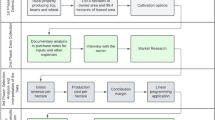Abstract
The paper is devoted to the use of the arable land of a farms. The farm want to have certain amount of productions from some crops. This policy of the farm has two purposes. First some products, e.g. silo, are used on further production levels. Furthermore the diversification of the finished product decreases the financial risk of the farm caused by the unknown future behavior of the markets. The aim is to determine that use of the fields, which guarantees the highest probability of the satisfaction of demand. Crop rotation determining that which crops can be produced in a field gives a natural condition to be satisfied. The problem is modeled and solved by stochastic programming. The results based on the data of a farm are provided.
Similar content being viewed by others
References
Bhuiyan, C. (2008). Desert vegetation during droughts: response and sensitivity. The International Archives of the Photogrammetry, Remote Sensing and Spatial Information Sciences, 37(B8), 907–912.
Dubrovsky, M., Svoboda, M. D., Trnka, M., Hayes, J., Wilhite, D. A., Zalud, Z., & Hlavinka, P. (2009). Applications of relative drought indices in accessing climate-change impacts on drought conditions in Czechia. Theoretical and Applied Climatology, 96(1–2), 155–171.
Guttman, N. B. (1999). Accepting the standardized precipitation index: a calculation algorithm. Journal of the American Water Resources Association, 35(2), 311–322.
Heim, R. R. (2002). A review of twentieth-century drought indices used in the United States. Bulletin of the American Meteorological Society, 83(8), 1149–1165.
Hisdal, H., & Tallaksen, L. M. (2003). Estimation of regional meteorological and hydrological drought characteristics: a case study for Denmark. Journal of Hydrology, 281(3), 230–247.
Kataoka, S. (1963). A stochastic programming model. Econometrica, 31, 181–196.
Koppány, G., & Makra, L. (1995). Persistence probability of the drought index made by Pálfai for five regions of the Hungarian great plain. Acta Climatologica, 28–29, 53–61. Universitatis Szegediensis.
Mika, J., Horváth, Sz., Makra, L., & Dunkel, Z. (2005). The Palmer Drought Serverity Index (PDSI) as an indication of soil moisture. Physics and Chemistry of the Earth, 30(3), 223–230.
Niermeyer, S. (1994). New drought indices. Options Mediterranéennes, Series A, 80, 267–284.
Pálfai, I., Boga, T. L., & Sebesvári, J. (2001). The experiences of the drought forecasting system helping in the preparation for irrigation. Presented on the XIX-th annual meeting of MHT (in Hungarian).
Prékopa, A. (1995). Stochastic programming. Norwell: Kluwer Academic.
Szabados, I. (2006). The effect of the precipitation on the three ring with. Carpathian Journal of Earth and Environmental Sciences, 1(3), 39–44.
Trnka, M., Dubrovsky, M., Svoboda, M., Semerádvá, D., Hayes M., Žalud, Z., & Wilhite, D. (2009). Developing a regional drought climatology for Czech Republic. International Journal of Climatology, 29, 863–883.
Vizvári, B., Lakner, Z., Kovács, G., & Csizmadia, Z. (2011). A stochastic programming and simulation based analysis of the structure of production on the arable land. Annals of Operations Research, 190(1), 325–337. doi:10.1007/s10479-009-0635-z.
Author information
Authors and Affiliations
Corresponding author
Appendices
Appendix A
In the example of Sect. 4 the regression equations of the yields of the three crops are the followings.

where PDI t is the value of the Pálfai’s Drought Index t years earlier. E.g. PDI 0 is the index of the current year. If year=1986 and all PDI t =3.5 then the value of the right-hand sides equal to the expected value of the yield in the example.
Appendix B
The value of the PDI or any other drought index is a random variable if it is accepted that the weather is a random phenomenon. Its distribution function D(⋅) was estimated in (Vizvári et al. 2011) as

where the values of the parameters are: ν=4.12678063, σ=1.43656559, ρ=0.01546327.
Appendix C
Tables C.3 to C.7 contain the fields which can be used for the crops according to the current state of the crop rotation, and the expected values of the yields and the harvested products.
Rights and permissions
About this article
Cite this article
Vizvári, B., Lakner, Z. A stochastic programming based analysis of the field use in a farm. Ann Oper Res 219, 231–242 (2014). https://doi.org/10.1007/s10479-013-1335-2
Published:
Issue Date:
DOI: https://doi.org/10.1007/s10479-013-1335-2




